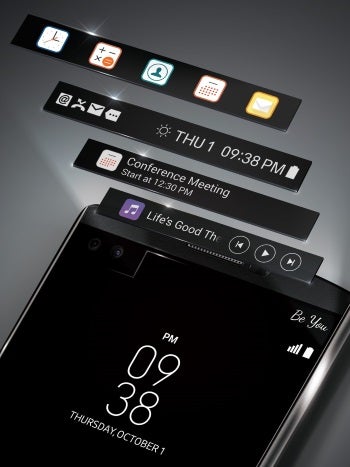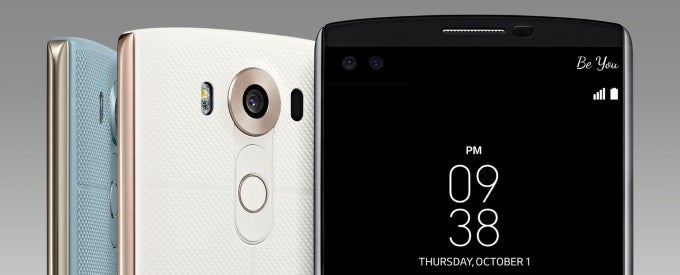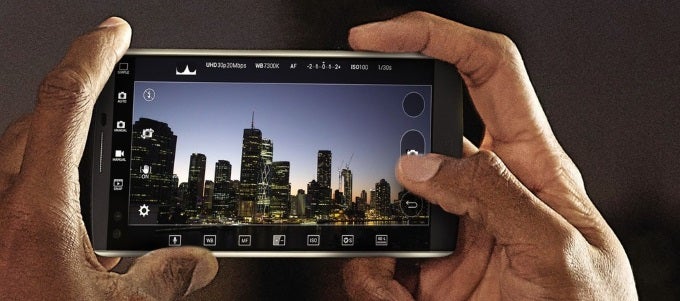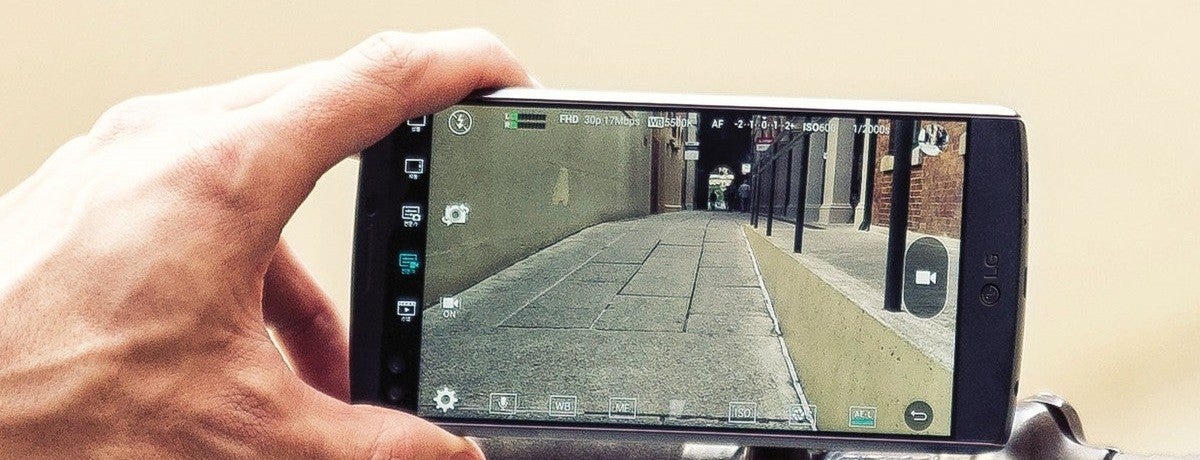LG V10: the specs review

Design
For the first time in a while, LG returns to the metal & plastic look it had going on with some of its older handsets, such as the Optimus 4X HD. That is, the plastic front and rear panels are held together by a sturdy frame that, interestingly enough, doesn't fully envelop the smartphone — it only accents the left and right sides, although the frame itself is anything but a piece of subtle decoration. It's giant, shiny, and imposing! It's also composed of SAE grade 316L stain-less steel, the same tough, hypoallergenic material used to make surgical tools and high- end watches.
To make the toughened-up V10 easier on the eyes, LG came up with some catchy colors in addition to the all too stern-looking black. We're talking white, beige, and two types of blue - 'ocean' and 'opal'. These look sexy and definitely add some appeal to the otherwise unassuming handset!

Display

So, how much stuff can you actually do with such pixel dense, yet small screen real estate? Obviously, the little screen isn't meant for essential functionality. With the main display on, the Second Screen can be set to convert to a dedicated launching area for shortcuts or your favorite apps. What's more, when you're enjoying a movie or game on the V10, the Second Screen will notify you discreetly without blocking your view when a call or text comes in. Nothing too fancy, folks, just some genuine usability thrown in for good measure!
Processor and Memory
Once again, LG opted for the Qualcomm Snapdragon 808 processor that also powers the LG G4. While doing fairly well in the general processing department, the 808 falls below last year's Snapdragon 805-powered smartphones in 3D graphics performance. This makes any smartphone powered by that processor, such as the LG V10 and the LG G4, hard to recommend for intense gaming sessions. Otherwise, the 808 can handle casual games and essential functionality, such as 4K video recording and playback, without any problems. Moreover, Qualcomm's SoC, which supports Cat. 9 LTE Internet speeds (450Mbps downlink), is paired with 4 gigabytes of LPDDR3 RAM for elaborate multitasking duties, and the V10's base model starts with a gracious 64GB of internal storage that's expandable via microSD card.

Camera
Oh boy, here's where it gets interesting! LG is putting serious effort into its camera experience, for not only does the V10 feature two 5MP front cameras, it's also the first smartphone to offer manual mode for video shooting! But the rear camera is pretty hot-shot as well, for it's a 16MP unit with F1.8 aperture and optical image stabilization, accompanied by the 'special sauce' stuff that we know from the LG G4 - a single LED flash, color spectrum sensor, and laser autofocus system. Overall, this camera setup is of the LG G4's very good level, and possibly even better! We'll reserve actual judgment for when we get to review the V10.
Camera sensors are one thing, but what about the software part of the equation, one that's almost equally as important? Well, LG weighed in on that too, copying and pasting the LG G4's lauded manual mode for still photography onto the video shooting mode! A first for smartphones, Manual Video Mode lets one adjust things like shutter speed, frame rate, ISO, white balance, and focus while recording. Videos can be recorded in three resolutions — HD, FHD or UHD — and two aspect ratios — 16:9 standard or 21:9 cinematic. With the active involvement of tech partner Qualcomm, LG also rounded out the camera app and software algorithms with features such as Steady Record (electronic image stabilization optimized for video), Quick Video Editor & Quick Share (allowing basic editing and fast sharing and social networks), and Audio Monitor (automatically adjusts the sensitivity of the three built-in microphones).

Fingerprint scanner
On top of everything else, LG finally caved in and got around to adding fingerprint security! The fingerprint sensor is built inside the power key and functions to securely unlock the smartphone and utilize Android Pay (in the United States). We don't know what kind of sensor LG uses in the V10, but given the company's position on the market, it should be a reasonably well behaving unit!
Multimedia
Giving proper attention where it's due, LG added a 32-bit Hi-Fi DAC by ESS Technology. Now, we can't be quite sure which of the numerious DACs made by ESS it is that LG has employed, but a dedicated chip can be counted on to provide a pretty sweet signal to noise ratio and transparent sound reproduction. ESS DACs support jitter elimination, integrated DSP processing, stereo/mono output, and user-programmable filters. Ultimately, though, it is what LG makes of the chip that will really matter for the user experience. According to LG, the V10 can "automatically detect connected devices and also provides sound control options which can be customized." We have a feeling something got lost in translation here, so we'll be seeing how things pan out with the V10's audio experience.

Antenna boosting tech
What do you know, the LG V10 happens to be the first commercial device to utilize Qualcomm's TruSignal antenna boost. Qualcomm is never keen on detailing its technology before the press and consumers, so all we can tell you is that the tech has been designed to intelligently optimize signal strength for fewer dropped calls, faster data and better call coverage, no matter how the phone is held.
Conclusion
What can we say, the LG V10 looks like a seriously impressive device that will catch the interest of phablet lovers with its large screen, grippy and durable build with just the right amount of elegance to not get lost among all the flashy aluminum devices out there, and of course, that dual camera and dual screen setup that's yet to have an alternative on the market. Although the Snapdragon 808 chipset powering it will cut its chances to perform amongst the gamer crowd, we expect LG to price the V10 a bit below competing high-end smartphones, which will become another strong point of its. The microSD slot and removable battery are also very desirable characteristics of its.
However, the V10 might have a pretty hard time sparing with the real heavy artillery out there, the Samsung Galaxy S6 edge+ and the iPhone 6s Plus. Both devices perform very fast, feature really good cameras, and offer outstanding design. Still, LG is obviously giving it a hard and honest try at competing with the big dogs while remaining true to its vision and customer feedback.
Follow us on Google News














Things that are NOT allowed:
To help keep our community safe and free from spam, we apply temporary limits to newly created accounts: